
There are few guns that capture the imagination like those from World War II. I got into shooting because of my interest in these classic weapons and my love of history. Finding these guns at shows or local stores became a sort of sport to me and I loved the idea of getting my hands on a piece of living history. In this article I will be taking a look at a unique rifle of American manufacture destined for British service: the Savage Enfield No. 4 Mk1.
Instead of boring you with a historical commentary that you could easily find in the dustier section of a library or the internet, I’ll give you quick summary of this gun and what its context. My particular example was made at Savage in 1943. It has simplified features as compared to earlier Enfield models. The nature of wartime manufacturing necessitated a reduction in machine operations and many features were either stripped down or made differently to speed up production time.
The gun was produced by Stevens, a division of Savage arms, in Massachusetts to fill the British demand for fighting rifles. During the early parts of the war, Hitler’s seemingly invincible forces were spanking virtually everyone in Europe and the British suffered as their manufacturing plants and industrial areas were bombed.
Ammunition for this and all TTAG reviews is sponsored by Ammo To Go. You can support TTAG by shopping at Ammo To Go for ammunition and more.
The British had little choice when it came to where they got their guns and American machinery began to make the quintessential weapon of the Empire in great number. The Lend-Lease Act passed in 1941 and American help was on the way. Note the “US Property” stamped on the receiver indicating its origin as the Lend-Lease Agreement with the United States, along with No.4 Mk I.
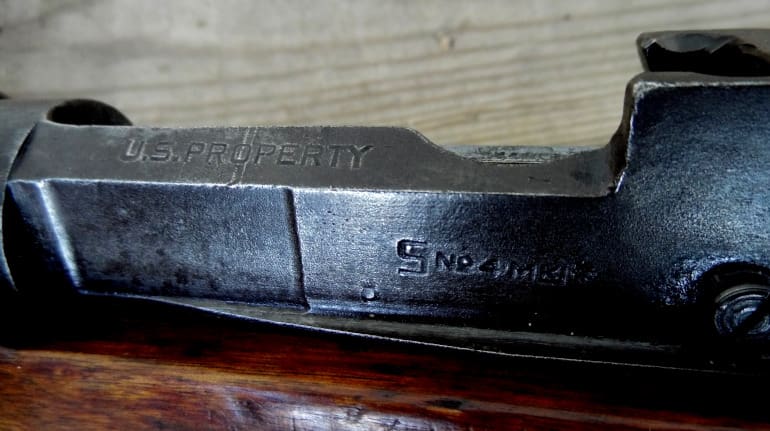
The gun itself is somewhat standard for the time period, but it had a number of features that made it, at least on paper, superior to other bolt actions of the era. For one, the rifle boasted a ten-round detachable box magazine. It was meant to be loaded by stripper clip and it was not issued with a spare. It was typically only removed for cleaning and maintenance, but the fact it held double the on-board rounds of a Nazi K98k made it a serious force on the battlefield.
Another feature that made the Savage Enfield an excellent rifle was that, unlike the American Springfield 1903/1903 A3 and German 98 Mauser, it was a cock-on-closing design with rear locking lugs. The Enfield action is a bit of a weird design when compared directly to the systems we know today, as virtually all modern bolt actions are derived from the Mauser action, including the Remington 700 and Winchester Model 70.
The entire mechanism is completely different from what most people know a bolt action to be and it represents a unique line of thinking that has sadly died off. I believe this is because there’s really no way to improve upon or further simplify the Enfield action and, because it was complex, it was determined to be impractical.
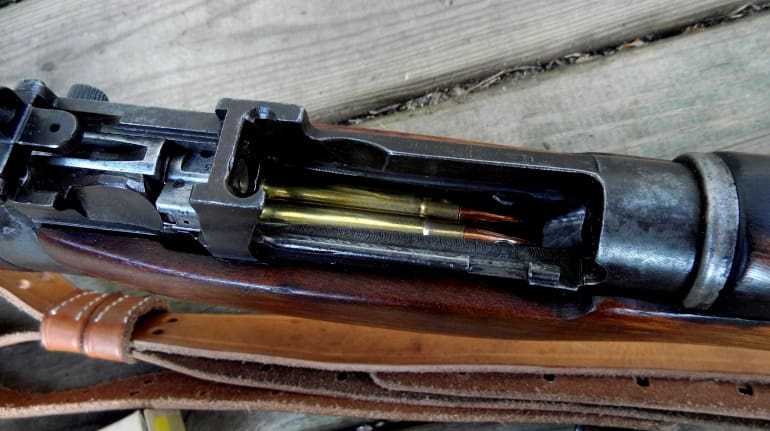
That said, there’s almost nothing out there like the Enfield action…except for other Enfields. The action is capable of being operated with incredible speed and smoothness and even a mediocre rifleman can deliver aimed fire at distance with almost the same speed and accuracy as an M1 Garand.
So slick and reliable is the Enfield action that the Mad Minute, fifteen shots on a target at 300 yards, is fully possible. The speed at which the Enfield action can be used is legendary, with some shooters being capable of emptying the 10-round magazine in less than ten seconds while aiming.
When it comes to accuracy, the Savage Enfield benefitted from American ideas and standards of precision. My example features a two-groove barrel that was easy to keep clean while being very precise. I’ve fired a number of Enfields that were made as long ago as the late 1800’s that were preserved in near-new condition and none were as accurate as this rifle.
Depending on what manual you read, the British service rifle was supposed to be able to put between ten and twenty rounds into a 6” square at 100 yards (or 6×4” @100yds, or a 48” square at 300 yards).
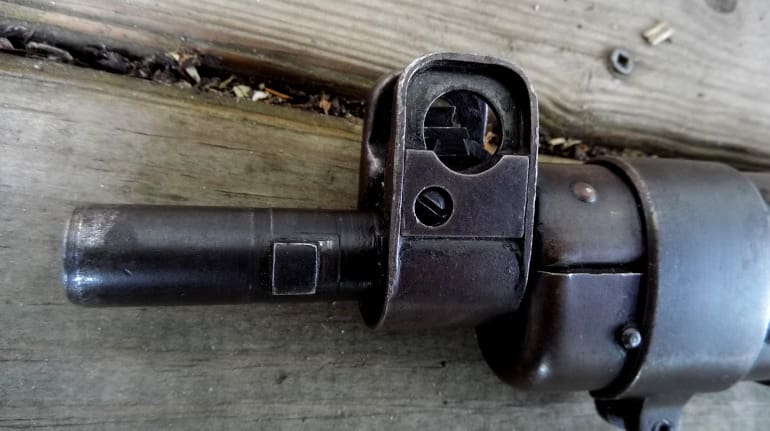
That seems like poor accuracy by American standards, but the British had a different idea of what a fighting rifle should do in combat. They were generally not as concerned with individual accuracy as the Americans, and this is evidenced by the fact that the individual American soldier was trusted to adjust his sights to his own zero, where the British typically had their sights set at the factory for a given load.
There were several heights of front sight that could be installed on the No. 4 Mk 1* that were designed to give the rifle a 300-yard zero. My rifle has a flip-up sight that is set for 300 and 600. Any other adjustments had to be made on the fly.
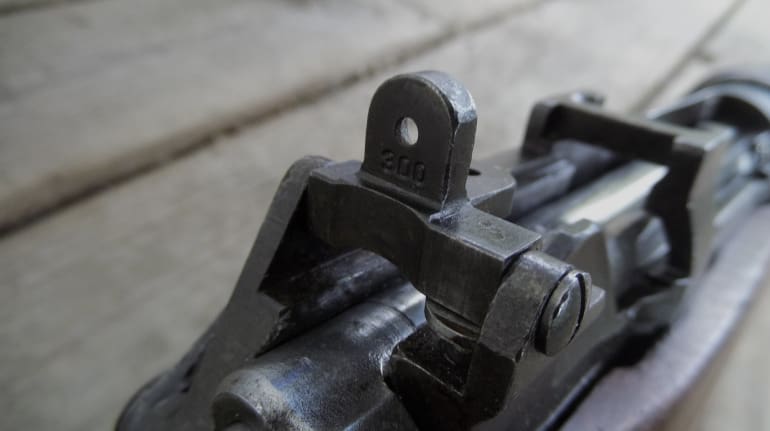
My rifle was fired with two kinds of ammunition at ranges of 100 yards, 300 yards, and 600 yards. I fired both Prvi Partizan 174 soft points and Hornady 150gr SP Interlock through the gun and chronographed them over my Oehler 35P.
The Prvi load was very accurate and generated ten-shot groups averaging 3.5” at 100 yards. Velocity averaged 2455fps at eight feet from the muzzle. The impact was about 17” high of point of aim at 100 yards. This load was dead-on at 300 yards and was capable of ringing my 10” steel plate every time by holding directly center. At 600 yards, it dropped low of point of aim by about a foot, which is close enough for government work.
The Hornady load displayed slightly better accuracy at 3” for ten shots at 100 yards. The average velocity was 2695fps and recoiled more sharply than the 174gr load. At 100 yards this load also shot high, this time about 15-16”. At 300 yards it was shooting high as well, but only by about 5”. I had to hold slightly under my plate to make it ring. At 600 yards it shot just about right on, which was strange to me, as I was expecting it to still be high.

I attempted some Mad Minute drills, but wasn’t able to work up to the speed. As a CMP competitor and regular at the Camp Perry National Matches, I thought I’d be able to meet the speed and accuracy requirements, but sadly I fell short.
CMP matches require ten rounds in 80 seconds at 200 yards with a mandatory reload (five and five for a bolt gun, two and eight for the M1), so my engrained pacing was off for trying 15 rounds with two reloads at 300 yards. With practice I’m sure I could make it. I think. Maybe.
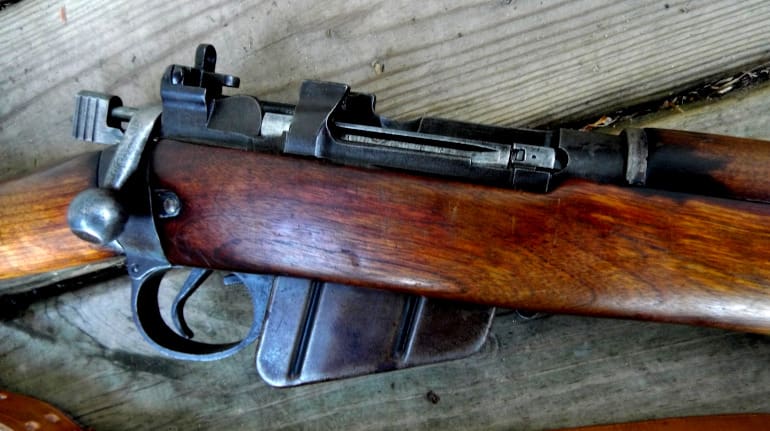
The Savage Enfield rifle is an interesting and important part of WWII history. It’s likely that more American-made Enfields served in the war than those produced by the British.
Obtaining one today that’s in good condition can be difficult, but it’s not impossible. Prices range from about $750 to around $1,200 depending on accessories, overall condition, and, honestly, who you buy it from. My rifle has a number of original and matching parts, a bayonet, and other items that place it in the higher cost range, but very serviceable examples exist in as good a shape as mine without all the goodies.
Specs: Savage Enfield No.4 MK1*
Barrel Length: 25”
Overall Length: 44.5”
Caliber: .303 British
Weight: 9lbs
Capacity: 10 rounds
Price: about $750 to $1200
Ratings (out of five stars):
Reliability: * * * * *
It wasn’t made by the French.
Accuracy: * * * * *
This is no target rifle, but it will see used it at the National Matches after I installed a dedicated 200-yard front sight. My example may not have won gold, but it certainly gave those damned Mausers a run for their money.
Ergonomics: * * * *
The sights are a bit hard to use and could be a little finer, but this is a fighting gun. It’s rugged as hell and has the hardened features to match.
Aesthetics: * * * *
Some consider it utilitarian, robust, hardworking, and overwhelmingly British…much like Tilda Swinton. But like Tilda, this rifle has taken many roles that a more fragile model couldn’t and it’s well remembered because of it.
Customize This: Don’t
Don’t even think about altering one of these, Bubba. It’s forgivable to file a front sight or install a new replacement part, but an extra-hot special circle of Hell awaits those who butcher military surplus rifles.
Overall: * * * *
This is a part of history, plain and simple. The Savage Enfield No.4 Mk1 is a classic and represents the finest of bolt action rifles.
Lee-Enfield




The speed record for a Enfield is 36 rounds a minute while hitting the target.
My grandfather, Australian Army WW 1 & 2 could still do 20 rounds in the 1960’s.
Never underestimate old men and treachery!
I have had cock on closing rifles (M1917 Enfield and Remington 788), and Mauser designs. Never noticed a speed difference, and do not see a reason to expect one. Not questioning the consensus, just wondering what the explanation is.
Maybe the difference in the forces applied? I know that whenever I’m running fast shots on a bolt gun, I tend to apply more force on the forward push to chamber the cartridge and lock the bolt, than I do the other way. And my bolt centerfires are a Rem 700 and a Mauser 98.
x. Not an expert. But I’ve owned and used all the big military bolt guns. Springfield, mauser, 1917 Enfield, etc. My own theory as to why the Lee Enfield is faster is due to the build weight of its action. It was designed to handle service loads for the .303 and no more. I’ve never seen a sporterized Lee Enfield chambered in anything heavier than .303.
There is enough extra beef in the actions of Springfields and Mausers to go a bit wild with customization jobs. Calibers bigger and badder than their designed service rounds.
It’s just my opinion but the Lee Enfield is built for one job. Rapid cycling of its intended round. I prefer the Lee Enfield in surplus rifles. But if I was going to build a dangerous game gun it would not be on that action.
Certainly mass and stroke length slow down the 1917. You could melt one down, and build 2 with the proceeds.
What a tank!
.25-.303 wildcat was a thing post war.
Ever see one?
Never heard of one til now. Interesting solution to the ozzies problem.
to Jethro the Janitor.
quote——— But if I was going to build a dangerous game gun it would not be on that action.—–quote
Your statement shows you know as much about calibers and rifles as you do about rocket science which is zero
Tens of thousands of dangerous big game including elephants were killed In Africa by poor white farmers and Black Game Rangers using nothing more than surplus British .303 Rifles and surplus Mausers, both in 7×57 and 8mm with surplus fmj ammo.
Like most hillbillies you bullshit much and read not at all. Most of the books on classic Africana would have taught you how moronic your statement is. Agnes Herbert, Stigand, Neuman, Forand, Taylor, Bell and a host of others wrote about Africa and the guns that were used there in that time period.
Several years ago a hunting video showed African Game Rangers culling a herd of elephant and they blew the elephants off their feet with nothing more than the issue FN FaL Rifle in 7.62 x 51 aka .308.
dacian. Good to see you’re still projecting your lack of iq and education onto others, Dunning-Krueger is your life choice.
People have killed big bears with .22’s. I don’t recommend hunting them that way.
If you knew anything at all about guns you would know that a dangerous game rifle is built overpowered for that reason.
Thanks for proving you’re a moron, again.
A Lee Enfield in the hands of Ali (Omar Sharif) as he made his entrance in Lawrence of Arabia …
saw that at the bryn mawr with maw. forty cents for kids, sixty for her.
In our mad-minute matches at 200m, 25-30 aimed rounds is quite common. And that’s from a standing start with the rifle at your feet.
Collectors who shoot these rifles should be aware that a change was made from the original bolt release mechanism. The Savage and the Canadian made guns were permitted to drop the plunger bolt release mechanism and simply mill a cut out in the receiver. This was done to speed up production but resulted in a lot of damaged receivers because the bolt would often flip up as it went forward over the cut out and then put a big chip in the receiver.
When operating the bolt on a Savage or Canadian made gun one should not rapidly operate the bolt rapidly or you will run the risk of destroying the receiver.
The horrendously heavy trigger (usually about 8 lbs) can be lessened quite a bit by a qualified gunsmith. I did trigger jobs on my enfields and have easily achieved a 3 lb. pull.
Various no drill and no tap mounts are also available for these guns. They do not require altering the receiver in any way that would of course totally destroy the collector value of these guns. Scoped these guns are capable of amazing accuracy. I have achieved 2 inch groups with no trouble at all and some 1 inch groups at 100 yards with match grade handloaded ammo.
Cast bullet loads are also very accurate in these Enfields. I usually size the cast bullet to .314 diameter and use straight linotype metal with a gas check.
Pull the other one. It has bells on it.
Where do I start?
The wartime models with gap in rail are generally not an issue. I’ve seen ONE out of several hundred examples with the bolt head popping out of the rail in cycling. The problem was fixed with a piece of spring steel to fill the gap which could be pulled out of the way when inserting or removing the bolt.
The M10B reproduction rifles used the same method to insert or remove the bolt. I’ve never had an issue with cycling. Nor have others with the M10s.
8lb trigger? Not on any of my Mk1 or Mk2 No4s. Only if Bubba was trying to make the trigger single-stage. If anything, the No4 Mk2 is my baseline trigger. The Mk1 is not as good but a lot better than many others.
I did try S&K no tap mounts but you need a cheek piece to make it usable. The Arctic Fox mount was so misaligned it was shooting to a different postcode. Learn to use iron sights.
Good .311-.312 diameter flat-base projectiles give good results.
to Southern Cross
Spring steel insert???? I have never heard of such a device. I am not saying it does not exist. If it does then give us a link to one for sale or at least a picture of this device. Otherwise I do not believe it exists.
it was a small tab of spring steel screwed to the receiver. While in operation it filled the gap allowing the bolt to the cycled normally. It could be pulled out of the way to insert or remove the bolt and being spring steel would return to position.
The owner was a machinist and tool maker by trade. The only time I’ve seen the bolt head issue happen. The track the bolt head ran in had a chip where the gap was.
—>” Otherwise I do not believe it exists.”
Nobody cares Dacian.
Shouldn’t you be simping for gun control somewhere?
dacian found something else written by someone else he can copy-n-paste from.
Military surplus rifles are just plain cool. Anytime I handle one I wonder about the soldier it was issued to. Where he carried it. What he had to do with it. My son began collecting them a few years ago. He has a sample of most. I always liked them too. I can hardly remember not owning an M-1 rifle or an ’03.
Well, I made reference to my pre-64 Winchester. It was actually my friends but when he passed, I got the firearms. I went to his house this morning to check on him and found him dead on the toilet. All the firearms I gathered up, including that 30/30 which is now officially mine.
Sorry to hear about your friend.
I am a fan of surplus weapons and history. My favorites are the Lee Enfields. I’ve had british and India in .303 and .308. They work. And keep working. The Indian rifles were not as accurate as the brits but they were good enough for their purpose.
All I know about .303’s and British Enfields is one a friend won in a card game.
We took it out and put a nice keyhole in a stop sign.
Surprised Price Albert hasn’t chimed in telling us the complete history of the Enfield rifles he worked on as an armourer for the British military. And then demand we hand over the Kings rifles since we are nothing but traitorous rebels anyway.
He would but he’s in the can right now.
Oh, he was here, but the dacian personality is in charge right now.
Or Madam Lash spanked him too hard with the spiked paddle.
Or Madam Lash wanted a pony ride but where the tail was positioned has left Prince among Kings Albert unable to sit down for a while.
i know of a .303 that’s taken a fair share of wisco whitetail.
I own a Savage No 4 Mk1/II FTR which I am quite happy with, but my Remington Eddystone P14 shoots rings around it. I am currently restoring a 1915 BSA No 1 MkIII* that I got for $35; it had been severely bubba’d with cut down forend painted a hideous GM car color and a black-painted buttstock that looked like it might have been parked too close to the woodstove. I tied the rifle to a spare tire and fired it with a lanyard, and discovered it functioned normally, with no signs of excess headspace, but keyholed rounds at 25 yards. I have since acquired a nearly perfect replacement barrel from a firm that used to do 7.62X39 conversions, and had it installed and headspaced to the original bolt head by a local gunsmithing firm that does extensive LEO work. Next step is finding woodwork and furniture to bring the old girl back into original trim. Wish me luck!
Mine is an Indian version in .308, same action but a more widely available round, teh magazine has a flat bottom instead of teh rimmed .303 rounded version. Nice rifle and capable of better accuracy than i am capable of with a front sight that tapers to a point.
Comments are closed.